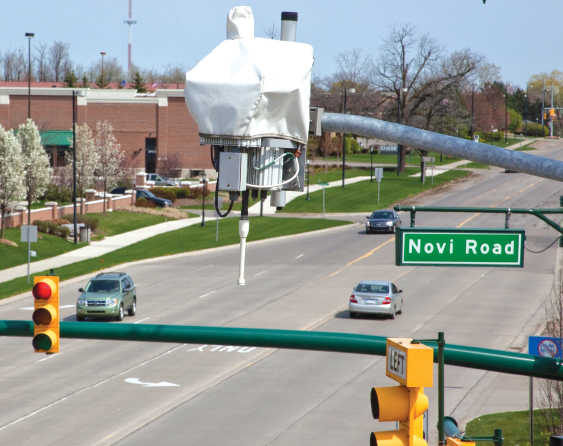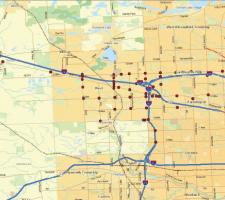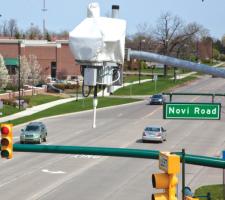
The Michigan Test Bed is equipped with 52 protoype DSRC units
Pete Goldin reports on upgrades to the USDOT's Michigan Test Bed, where IntelliDrive technologies are being pioneered
The future of vehicle communication is being innovated right now, on the Michigan roads of Novi, Farmington, Farmington Hills, and Livonia, as part of the USDOT's Michigan Test Bed.Designed to test IntelliDrive technologies and applications, the Michigan Test Bed is located on 75 miles of highway and arterial roadway located in Oakland County, Michigan. The Test Bed is equipped with 52 Dedicated Short Range Communications (DSRC) RoadSide Equipment (RSE) units.
What many ITS companies may not realise is that the Test Bed is available to them to test next-generation vehicle communications technology. Moreover, technical upgrades to the facilities which are designed to maintain their currency have either already been completed or are in hand.
"The USDOT picked the Detroit area as the home of the Test Bed because the OEMs are here," explains Frank Perry, associate with
Vision of the future
"Imagine a world where highway crashes and their tragic consequences are significantly reduced," says the IntelliDrive website. "Vehicles will be able to 'talk' to traffic signals to eliminate unnecessary stops - saving travel time and fuel, and reducing emissions; travelers have continual access to accurate travel time information about all mode and route options, and the potential environmental impacts of their choices; transportation system managers have the real-time data they need to accurately assess transportation system performance and actively manage the system for optimal performance." This is the USDOT's vision for IntelliDrive. Understanding the important role the Michigan Test Bed plays in the future of transportation requires an understanding of IntelliDrive, a multimodal initiative with the goal of developing interoperable networked wireless communications between vehicles and the roadway infrastructure to improve the safety and mobility of the US transportation system. The IntelliDrive program is a major initiative of the USDOT's"The Michigan Test Bed, which was deployed by the USDOT in the Novi area in Michigan, provides a unique testing environment on public roads," says Udi Naamani, general manager of the Connected Vehicle Proving Center. "Maintaining and improving this installation as a test site can be critical to the success of the IntelliDrive programme."
Honing communication skills
The first RSE was installed in the Test Bed in September 2007, and application testing was finally completed one year later. The Test Bed has been in use ever since.On the freeway, the RSEs are attached to the state's CCTV camera poles, and on arterials the RSEs are mounted on traffic signal poles owned by the Road Commission for Oakland County (RCOC).
"The DOT wanted to capture information on a selection of different types of intersections with both low- and high-speed traffic," Perry explains. "They also wanted areas where the radio ranges of RSEs would overlap each other, to see how vehicles and the system would interact with multiple RSEs.
Perry adds that the biggest challenge is that the Test Bed is using prototype equipment, which is not as robust as he would like. The hardware must be replaced periodically, and the Booz Allen Hamilton team has to use the services of the RCOC every time it has to perform any type of onsite maintenance.
The USDOT provides 10 vehicles, seven Jeep Grand Cherokees and three Ford Edges, for the Michigan Test Bed; each one is equipped to communicate with roadside units. These particular models were selected primarily because they had space for navigation systems, which were replaced by the Test Bed's onboard equipment.
The two-way communication system enables the vehicles driving on the Test Bed to collect and send probe data such as location, speed and heading, and also to retrieve and send data from onboard sensors monitoring traction control, whether headlights or windshield wipers are operating, and even tyre pressures.
The probe data can be used by traffic management and emergency management services to respond to real-time events such as congestion but can also provide historical data for trending and analysis purposes. Perry says the data can be used to help detect potholes, slippery surface and other dangerous conditions which need to be addressed by those responsible for traffic management.
Conversely, the vehicles can receive text messages as well, such as travel times, construction zone warnings, alternative routes and amber alerts - many of the same notifications that would traditionally be posted on variable message signs.
Building a better bed
The Michigan Test Bed is currently undergoing a system upgrade to ensure stability and reduce the downtimes of both the network and the vehicles' equipment.On the network side, there are times when the system will just stop producing probe data, Perry says, adding that typically one or two RSEs go down every day. This problem usually requires a simple reboot of the RSE's Linux platform, which can be performed remotely from a central console. Perry either does a soft reboot by sending a command to the RSE, or he can power cycle the unit remotely via an intelligent power module that allows him to toggle the power outlet for the RSE. This capability was part of a previous upgrade, and Perry says it has been a significant advantage. He notes that as part of the current upgrades, they have implemented software modifications and application upgrades to minimise outages in the future.
The Test Bed has deployed Progress Software's SonicMQ - a JMS (Java Message Standard)-based messaging server - as the message broker for all the RSEs to deliver probe data from the vehicles and advisory messages to the drivers.
In addition, the DOT has increased network security measures to prevent hackers from accessing the Test Bed network, and they have also deployed a network monitoring system - the enterprise version of the Zenoss open-source monitoring solution.
"We developed our own in-house web application to monitor all the RSEs, so we could always tell when a RSE was up or down," Perry says. "But we wanted more metrics, so we could do trending and analysis, to proactively identify if something is going wrong before it becomes a larger problem.
"With the additional metrics, we learn something new about the system every day," he adds. "We are figuring out what it takes to run a system like this, so we need to collect as many metrics about each individual component as possible. Everything we learn helps us operate the Test Bed, but it is also helping us work out the bugs of the real-world IntelliDrive network." The upgrades started in early October 2009. The last step of the upgrade includes the implementation of a configuration management tool to automate configuration of all RSEs with a couple of clicks of a button, as opposed to manually editing files.
Time to go to bed
Once the Test Bed is fully upgraded, the USDOT plans to be more aggressive about publicising its availability to the OEM community."The USDOT is encouraging third parties to come and use the Michigan Test Bed," says Perry. "There is no cost to use the network or the vehicles. Organisations only need to provide drivers and cover the cost of fuel." The USDOT provides equipped vehicles, and third-party researchers have the option to use this technology or install their own applications in the vehicles. The researchers can also bring their own vehicles.
The possible uses of the Michigan Test Bed are almost limitless, and many of the organisations that will use the Test Bed are not the most obvious. NCAR (
Meanwhile, Perry says the USDOT is already looking at further potential Test Bed upgrades for the future, such as adding WiFi or cellular communications. Another important next step is to bring the communications protocols up to current revisions of standards.
"The USDOT's vision is for the Michigan Test Bed to not only serve as a benchmark for a national IntelliDrive deployment, but in the end they plan to turn this network over to either the state or county to use as an actual IntelliDrive environment," he says.
How IntelliDrive will be implemented in the real world remains to be seen, however. There are many unanswered questions, such as how will vehicles become equipped with the onboard systems? Will the Federal government mandate that all vehicles must have the IntelliDrive equipment installed by the automotive OEM? If not, IntelliDrive could depend on the aftermarket, resulting in many inconsistencies in terms of the onboard equipment and the data it provides. But first things first.
"The USDOT's intention is simply to get something out there and start the momentum," Perry concludes, assuming that at some point there will have to be a minimum amount of data coming from every vehicle. "It is better at least to have the location, heading and speed than to have nothing at all."













